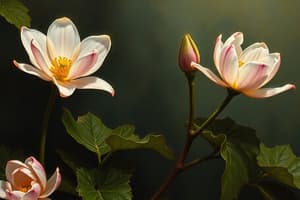Podcast
Questions and Answers
In vascular plants, what is the primary mechanism that facilitates the movement of male gametes to female gametes?
In vascular plants, what is the primary mechanism that facilitates the movement of male gametes to female gametes?
- Water-dependent flagellated sperm swimming to the archegonia.
- Pollen grains transported by wind or animal vectors to the carpel. (correct)
- Direct transfer via mycelial networks connecting different plants.
- Wind-dispersed spores landing near the archegonia.
A botanist observes a plant with parallel leaf veins, scattered vascular bundles in the stem, and a fibrous root system. Which of the following conclusions is most likely correct?
A botanist observes a plant with parallel leaf veins, scattered vascular bundles in the stem, and a fibrous root system. Which of the following conclusions is most likely correct?
- The plant is a fern and reproduces via spores in sori.
- The plant is a liverwort and lacks true vascular tissue.
- The plant is a eudicot and likely possesses a taproot system.
- The plant is a monocot and its flower parts occur in multiples of three. (correct)
During a period of drought stress, a plant's stomata close to conserve water. How does this stomatal closure primarily affect the process of photosynthesis?
During a period of drought stress, a plant's stomata close to conserve water. How does this stomatal closure primarily affect the process of photosynthesis?
- It promotes the uptake of water through the roots, increasing turgor pressure.
- It prevents the entry of $CO_2$ into the leaf, limiting the Calvin cycle. (correct)
- It increases the concentration of oxygen within the leaf, enhancing photorespiration.
- It enhances the light-dependent reactions by trapping more sunlight.
A researcher is studying the effect of different wavelengths of light on photosynthetic efficiency. Based on the known properties of plant pigments, which of the following light treatments would likely result in the highest rate of photosynthesis?
A researcher is studying the effect of different wavelengths of light on photosynthetic efficiency. Based on the known properties of plant pigments, which of the following light treatments would likely result in the highest rate of photosynthesis?
The cohesion-tension theory explains how water moves through plants. If the diameter of xylem vessels were significantly increased, what effect would this likely have on the rate of transpiration?
The cohesion-tension theory explains how water moves through plants. If the diameter of xylem vessels were significantly increased, what effect would this likely have on the rate of transpiration?
Flashcards
What are fern sori?
What are fern sori?
Clusters of sporangia on fern leaves where spores are produced.
Cohesion-Adhesion in Transpiration
Cohesion-Adhesion in Transpiration
Water moves up a plant due to hydrogen bonds from water molecules sticking together (cohesion) and to the plant walls (adhesion).
Stomata Location
Stomata Location
Most stomata are found on the lower leaf surface to reduce water loss by decreasing direct sunlight exposure.
Effective Light Wavelengths
Effective Light Wavelengths
Signup and view all the flashcards
Stomata Closure
Stomata Closure
Signup and view all the flashcards
Study Notes
- Focus on reproductive structures of ferns, including what fern sori contain, monocot vs. eudicot/dicot differences, liverwort vs. moss vs. fern differences, how male gametes reach female gametes in nonvascular and vascular plants, flower structures and function, pollination and fertilization for angiosperms, immature and mature stamen and carpels, where pollen grains and egg cells are made, how sperm nuclei reach egg nucleus, seed/embryo development, transpiration and stomatal peel, cohesion/adhesion in transpiration, transpiration in plants, stomata concentration, capillary tube diameter, potometer, light reactions and Calvin cycle, effective wavelengths for photosynthesis, adverse weather conditions that close stomata, plant pigments involved in photosynthesis, and stomata number related to transpiration rate.
Fern Reproduction
- Fern sori contain structures related to reproduction.
Monocots vs. Eudicots/Dicots
- Need to distinguish between monocot and eudicot/dicot leaves, stems, and roots.
- Monocots and eudicots/dicots differ in leaf and stem vascular arrangements.
Liverworts vs. Moss vs. Ferns
- Liverworts, mosses, and ferns have differences in archegonia and antheridia.
Gamete Transfer
- Male gametes reach female gametes differently in nonvascular and vascular plants.
Flower Structure and Function
- Need to identify all flower structures and their function.
Angiosperm Reproduction
- Focus on where and how pollination and fertilization occur for angiosperms.
- Distinguish between immature and mature stamen and carpels.
- Pollen grains and egg cells are made in specific locations.
- Understand how sperm nuclei reach the egg nucleus.
Seed and Embryo Development
- The process of seed and embryo development, must be understood.
Transpiration
- Cohesion and adhesion play a role in transpiration.
- Transpiration occurs in plants beginning at the roots and ending at the stomata of the leaf.
- Stomata are more concentrated in specific areas, and there is a reason for this.
- The diameter of a capillary tube affects the distance fluid can travel.
Potometer
- Understand how a potometer can be used to study transpiration.
Photosynthesis
- Understand the light reactions and Calvin cycle of photosynthesis.
- Specific wavelengths of light are most effective for photosynthesis to occur.
- Adverse weather conditions can cause stomata to close during the daytime.
- Plant pigments are primarily involved in photosynthesis.
Stomata and Transpiration
- The number of stomata relates to the rate of transpiration.
Studying That Suits You
Use AI to generate personalized quizzes and flashcards to suit your learning preferences.




